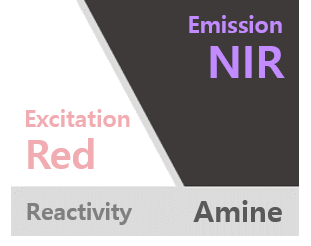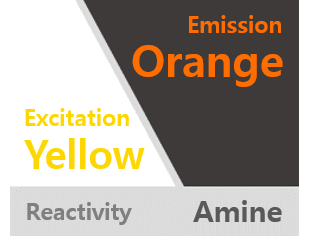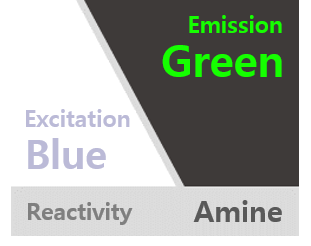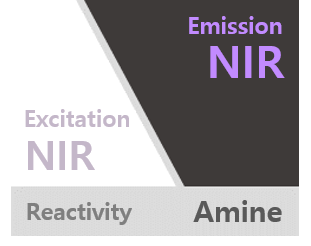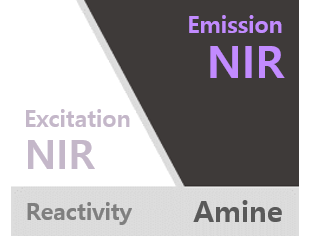
FSD Fluor™ 647 NHS ester
| PACKING UNIT | price |
Lead time |
|---|---|---|
| 1 mg | $273.00 | |
| 5 mg | $1,082.00 | |
| 25 mg | $3,378.00 |
Description
FSD Fluor™ 647 NHS ester is the new generation of amine reactive far-red fluorescent dye developed by BioActs’ cutting-edge technology displaying excellent optical property comparing to spectrally similar dyes. The fluorescence intensity after binding to biomolecules such as antibody, nucleotide, and protein is also excellent, thus FSD Fluor™ series is ideal for various biochemical and biological analytical applications. FSD dye is conceivably the best existent dye for single-molecular detection of bioconjugates for fluorescence correlation spectroscopy and for fluorescence polarization measurements. The maxima of Ex/Em values are at 651/667 nm, similar to that of Alexa 647, Cy5 and DyLight 650. FSD 647 might be excited using 593 or 633 nm laser lines and displays excellent optical property. FSD 647 can be conjugated to low-abundance biomolecules with great sensitivity and high molar ratios, allowing sensitive detection. NHS esters readily react with amine-modified oligonucleotides or amino groups of proteins, i.e. the ε-amino groups of lysine or the amine terminus of nucleotides to form a chemically stable amide bond between dye and the biomolecule. We offer FSD Fluor™ 647 NHS ester for labeling of antibodies, peptides, proteins, ligands, and amplification substrates optimized for cellular labeling and detection.
Citation & Reference
1. Le NT, Viscosity regulation of chemically simple condensates. Biomacromolecules. 2024 Aug 21;25(9):5959–67.
2. Jeon H-J, N-methyl-D-aspartate receptors induce M1 polarization of macrophages: Feasibility of targeted imaging in inflammatory response in vivo. Cell & Bioscience. 2023 Mar 30;13(1).
3. Mathew AP,Hyaluronan-coated Prussian blue nanoparticles relieve LPS-induced peritonitis by suppressing oxidative species generation in tissue-resident macrophages. Biomaterials Science. 2022;10(5):1248–56.
4. Han SJ, Electric fields regulate cellular elasticity through intracellular Ca2+ concentrations. Journal of Cellular Physiology. 2021 May 16;236(11):7450–63.
5. Yhee, Ji Young. Cancer-targeted MDR-1 siRNA delivery using self-cross-linked glycol chitosan nanoparticles to overcome drug resistance. Journal of Controlled Release 198 (2015): 1-9.
6. Lee, Eunjung. Co-delivery of chemosensitizing siRNA and an anticancer agent via multiple monocomplexation-induced hydrophobic association. Journal of Controlled Release 210 (2015): 105-114.
7. Park, Solji. Amphiphilized poly (ethyleneimine) nanoparticles: a versatile multi-cargo carrier with enhanced tumor-homing efficiency and biocompatibility. Journal of Materials Chemistry B 3.2 (2015): 198-206.
8. Hollis, Christin P. In vivo investigation of hybrid paclitaxel nanocrystals with dual fluorescent probes for cancer theranostics. Pharmaceutical research 31.6 (2014): 1450-1459.
9. Yoon, Hong Yeol. Glycol chitosan nanoparticles as specialized cancer therapeutic vehicles: Sequential delivery of doxorubicin and Bcl-2 siRNA. Scientific reports 4 (2014).
10. Oh, Keun Sang. Accurate sequential detection of primary tumor and metastatic lymphatics using a temperature-induced phase transition nanoparticulate system. International journal of nanomedicine 9 (2014): 2955.
11. Lee, So Jin. TNF-α gene silencing using polymerized siRNA/thiolated glycol chitosan nanoparticles for rheumatoid arthritis. Molecular Therapy 22.2 (2014): 397-408.
12. Yoon, Hong Yeol. Bioreducible hyaluronic acid conjugates as siRNA carrier for tumor targeting. Journal of Controlled Release 172.3 (2013): 653-661.
13. Yhee, Ji Young. Tumor-targeting transferrin nanoparticles for systemic polymerized siRNA delivery in tumor-bearing mice. Bioconjugate chemistry 24.11 (2013): 1850-1860.
14. Yoon, Hong Yeol. Photo-crosslinked hyaluronic acid nanoparticles with improved stability for in vivo tumor-targeted drug delivery. Biomaterials 34.21 (2013): 5273-5280.
15. Keunsoo Jeong. Poly (oxyethylene sugaramide) s: unprecedented multihydroxyl building blocks for tumor-homing nanoassembly. Journal of Materials Chemistry B 1.28 (2013): 3437-3442.
16. Park, Jin Woo. Wide-Ranged Fluorescent Molecular Weight Size Markers for Electrophoresis. Bulletin of the Korean Chemical Society 34.1 (2013): 29-30.
17. Huang, Xinglu. Multiplex Imaging of an Intracellular Proteolytic Cascade by using a Broad Spectrum Nanoquencher. Angewandte Chemie International Edition 51.7 (2012): 1625-1630.
18. Koo, Heebeom. The movement of self-assembled amphiphilic polymeric nanoparticles in the vitreous and retina after intravitreal injection. Biomaterials 33.12 (2012): 3485-3493.
19. Zhu, Lei. Real-time monitoring of caspase cascade activation in living cells. Journal of controlled release 163.1 (2012): 55-62.
20. Lim, Chang-Keun. Gadolinium-coordinated elastic nanogels for in vivo tumor targeting and imaging. Biomaterials 34.28 (2013): 6846-6852.
21. Lim, Chang-Keun. Phthalocyanine-aggregated polymeric nanoparticles as tumor-homing near-infrared absorbers for photothermal therapy of cancer. Theranostics 2.9 (2012): 871-879.
22. Park, Jin Woo. Novel cyanine dyes with vinylsulfone group for labeling biomolecules. Bioconjugate chemistry 23.3 (2012): 350-362.
23. Ryu, Ju Hee. Early diagnosis of arthritis in mice with collagen?induced arthritis, using a fluorogenic matrix metalloproteinase 3–specific polymeric probe. Arthritis & Rheumatism 63.12 (2011): 3824-3832.
24. Ibrahim, Basma M. A strategy to deliver genes to cystic fibrosis lungs: a battle with environment. Journal of controlled release 155.2 (2011): 289-295.
25. Xu, Peisheng. Zwitterionic chitosan derivatives for pH-sensitive stealth coating. Biomacromolecules 11.9 (2010): 2352-2358.
OPTION
Total

 log
log My
My Contact
Contact

